
 t>0 (1)
t>0 (1)
ABSTRACT
The aim of this work is to present the possibilities and recent experiences with the use of algebraic computation in the apprenticeship of different areas of Mechanical Engineering. The software used in this work was MAPLE V 1,2,3,4,5, a powerful algebraic program that is capable of performing computation with symbolic expressions. Two typical applications in Heat Transfer and Mechanical Vibration are presented, with commented solutions, displayed in two and three dimensional graphics. Methodology, difficulties, and the opinion of some lecturers are also presented.
INTRODUCTION
Computers have become an important instrument to the progress of Science and Technology. Very complex and time-consuming calculations can now be easily done by computer programs. More recently, algebraic computation has greatly enhanced the capability of computers to deal with complex mathematical problems. It seems natural that the use algebraic computation should be extended to Engineering Education. Algebraic calculations, applied to practical engineering problems, have shown to be a powerful tool for teaching in undergraduate courses. This has already been done in a number of areas such as: Mathematics6, Thermodynamics7, Strength of Materials8, Fluid Dynamics9, Vibration10 and others. For example, extensive calculations needed in series expansion can now be done quickly with the use of algebraic computation. In engineering education, algebraic computation has the advantage of presenting the results of some specific engineering program directly in algebraic form. This represents an additional source of encouragement to the student.
With the advancement of technology, more ways of entertainment have been made available to the student. They include cable TV and powerful personal computers, which have been commercialized as domestic appliances. In the first place, it has become even more difficult to keep the student's attention for two-hour long conventional classes. On the other hand, the natural interest of students to the computer can be advantageously drawn to the use of instructional packages to their course work.
In the following sections a brief outline on algebraic computation is given, followed by typical applications to engineering problems. The paper closes with a discussion on faculty opinion and partnership possibilities.
ALGEBRAIC COMPUTATION
Computers have been traditionally used to perform numerical computation. Engineering problems were translated into mathematical equations which were solved with the help of numerical methods. Numbers were generated and translated into graphical form, with the use of some package or subroutine. Programming languages, such as FORTRAN, PASCAL, C, BASIC, to name but a few, are employed for the calculation of, for instance, polynomial roots, numerical values of functions, or eigenvalues of matrices. In all these cases, with the traditional computing languages, only numbers are presented. Algebraic computation pushes the computer capabilities even further.
With algebraic computation solution is provided in the form of numerical results as well as in algebraic or symbolic form. Usually, a graphical form is also presented. The advantages of computer algebra systems are obvious: tedious manipulations of long algebraic equations can be carried out with ease and less chance of error. There are today several computer algebra systems, including: MATHEMATICA, DERIVE, MAPLE V, FORM, REDUCE and MATLAB (all trademarks). Heck11 gives an overview of these systems, indicating that there is a number of WWW-servers12 dedicated to computer algebra.
The first experience of the Catholic University of Petrópolis (UCP) on algebraic computation was DERIVE software. It was employed firstly at the start of the engineering course, to teach Calculus. Results showed an increase in student encouragement, higher grades and a decrease in student failure. DERIVE was also employed in local high schools (city of Petrópolis) for the teaching of Mathematics and Physics. Theory was presented in the conventional class and homework exercises were handed to the student to be carried out with the help of DERIVE. A first assessment of the project indicated that, at least, the students were able to perform more exercises than should a traditonal method be used. MAPLE V was the second software employed in UCP. Today this software is used in Calculus, Mechanical Vibration and Heat Transfer, with a strong emphasis on the latter. A third package, MATLAB, is also used in UCP for the simulation of dynamics control systems. The present work uses MAPLE V Release 4 to present the possibilities of the use of an algebraic computation system to act as a teaching tool.
APPLICATIONS TO MECHANICAL ENGINEERING COURSES
In this section, two examples are given on how an algebraic computation program (in the present case, MAPLE V) can be used as a teaching tool to Mechanical Engineering courses. Two problems, in heat transfer and mechanical vibration, are proposed. The mathematical formulation is presented and the analytical solution, developed by MAPLE V, discussed.
Heat Transfer problem
Consider a slab of uniform thickness L with a initial temperature distribution F(x). For t>0, boundary conditions at x=0 and x=L will be defined later, for two specific problems, as shown in Figure 1. Develop an expression for the one-dimensional, time-dependent temperature distribution, T(x,t), in the slab. The differential equation to this problem is:

 t>0 (1)
t>0 (1)
where (alpha) is the thermal diffusivity of the slab material. The initial condition is13:
 (2)
(2)
where F(x) is an arbitrary function of x. The solution of equation (1) is, by the method of separation of variables14:
 (3)
(3)
where (xi(lambdan,x)) are eigenfunctions, (lambda)n are eigenvalues and N is the normalization integral.
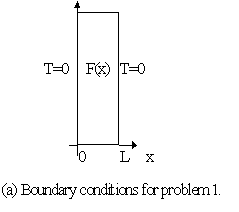 |
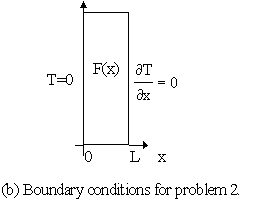 |
Figure 1 - Boundary conditions for heat transfer problems. up
Özisik14 tabulated eigenfunctions, eigenvalues and normalization integral for several combination of boundaries conditions.
MAPLE V is applied here to present the solution using Equation (3). In problem (a) the boundary conditions at x=0 and x=L are: prescribe temperature T(0,t)=0 and T(L,t)=0, respectively. In problem (b), the boundary conditions are: prescribe temperature at x=0, equal to T(0,t)=0 and insulate at x=L, as shown in Figure (1). A complete solution, performed by MAPLE V, is shown in Appendix A.
Note that, in a classroom with computer facilities, with the help of an algebraic computational program, the same problem, with several different boundary and initial conditions, can be proposed, solved and discussed. Graphical output, readily available, makes the teaching process highly effective. Numerical computation would, of course, be able to produce the same results, but at much higher a cost. It should be mentioned that example (1a) was prepared during class, before the students. If students wish to develop their own numerical programs, in either FORTRAN or C, a translation of MAPLE V to FORTRAN or C format, respectively, is available, as commented in step 3 of Appendix A.
Mechanical Vibration problem
The problem of mechanical vibration follows: a mass m is suspended from a spring of modulus k. A disturbing force F is applied on the mass. The damping coefficient is c, as shown in Figure 2.
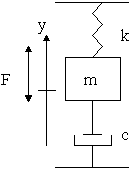
Figure 2 - Schematics of the Mechanical Vibration problem.
The differential equation for this problem is15:
 (4)
(4)
The right-hand-side of Equation (4) is the forced vibration term, and is the frequency of motion. The complete solution to Equation (4), as produced by MAPLE V, is presented in Appendix A. In particular, MAPLE V Release 4 has also the advantage of solving differential equations. This feature is also shown.
METHODOLOGY
A methodology for the use of an algebraic computation program in class is here suggested. First, theory is presented. Then, a problem is proposed, followed by the definition of boundary and initial conditions. This problem is solved in class by conventional methods (blackboard and chalk). Further, a solution with MAPLE V is presented, with the use of transparencies and copies that are handed to the class. If computational facilities are available in class, the solution can be projected on the screen and followed by students through network. Usually the presentation of a solution to an otherwise very complex engineering problem causes a great deal of satisfaction among the students, who see that the harder work was carried by the computer, not them.
With conventional methods of teaching, only a few problems can be solved, either in class or by the student at home. This new technology of algebraic computation turns class into a quicker and more versatile event, leaving the teacher with more time to show different combinations of boundary conditions. More emphasis is put on the on mechanical engineering aspects of the problem with less "mathematics". Algebraic computation brings more versatility to the students, who will have more time left to be spent with the physical understanding of the phenomenon.
FACULTY OPINION
Opinions on the introduction of algebraic computation to engineering courses range betwen extremes. There are professors that are very enthusiastic about it, to the extent they believe that a Mechanical Engineering course can be completed in two and a half years only. It is the authors' opinion that laboratory experience and the process of gaining a perception for physical reality takes time. A computer will never show the student what one kilogram is like. On the other extreme there are those, usually among the senior staff, that are against computer algebra. Their argument is that the students should learn by working themselves toward the solution of the problem. In fact, this argument is correct but, once the student learns how it is done, his/her horizons can be greatly extended by the use of a tool that is capable of finding solutions that, by their very complex nature, would otherwise be never pursued. Also, it should be stressed that, for the majority of engineering disciplines, Mathematics should be a tool not a goal.
Some lecturers see the use of algebraic computation as just another way of teaching Mathematics to engineering students, no matter what the course is. However, main objective should to fully understand the physical process. Algebraic computation should be viewed simply as an aid to overcome lengthy, tedious and sometimes rather complex algebraic manipulations.
Few lecturers are already familiar with algebraic computation, which precludes a more widespread introduction to undergraduate courses. Others say that most algebraic computation packages are difficult to deal with, their response is not satisfactory and that the user spends a long time to understand the output of the software.
If the student becomes too much involved with the program, there is a risk of alienation, i.e., the student "stops thinking" . The physical perception of the problem can be lost with too much algebraic computation. However, this problem is not restricted to the cases when algebraic computation is used and may also occur should the course be thaught in a conventional manner or with some traditional numerical computation.
It takes time for the student to get acquainted with a new program. This time can become even greater if professors opt for different packages. However, it is believed that a standardization would not be practical in universities.
PARTNERSHIP
Concerning the partnership among institutions, a few measures can be envisaged:
CONCLUSION
The present work has shown the potential of using algebraic computation in mechanical engineering courses. Even though the examples were restricted to Mechanical Engineering, the main points of the paper could be easily extended to other fields of Engineering.
Present evidences point to a future where algebraic computation will become as common in undergraduate courses as any other numerical language is today. Even without the consent of the lecturer, algebraic computation will be likely to find widespread use among students. Faculty should be prepared for that.
ACKNOWLEDGMENTS
The authors would like to thank CAPES and CNPq (both Brazilian Government agencies) for the financial support. They are also indebted for all the undergraduate students who helped, with great patience and hard work, with the making of this paper.
APPENDIX A
In the following pages, the use of MAPLE in the solution of the a heat transfer problem and a mechanical vibration problem will be shown. The following notation is used: MAPLE V keywords are in typewriter font and comments are in Times New Roman font.
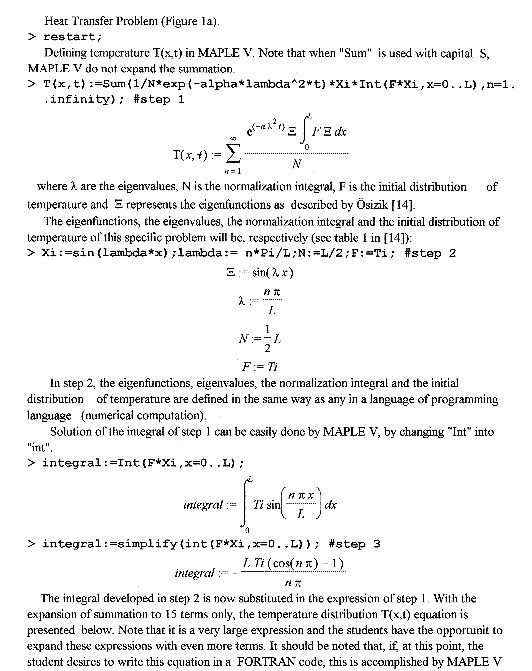
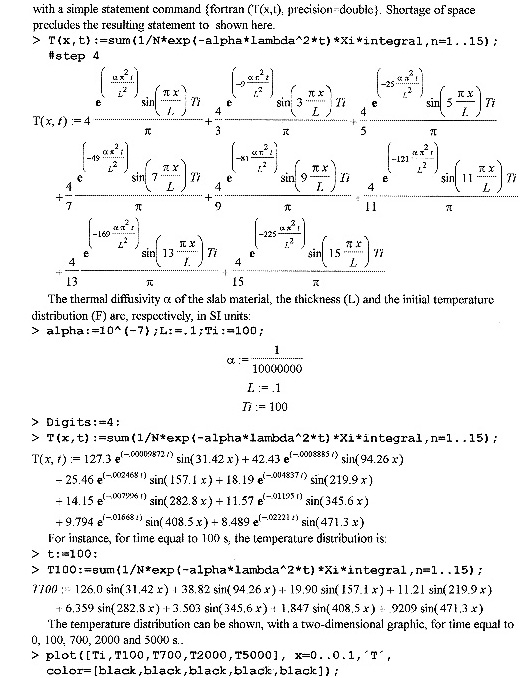
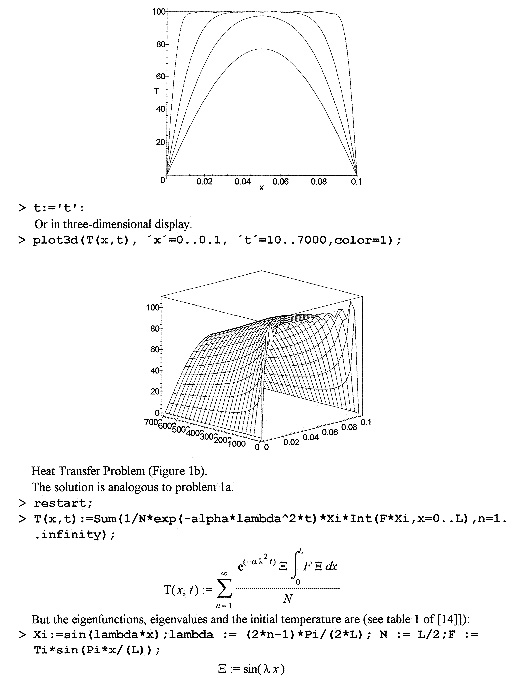
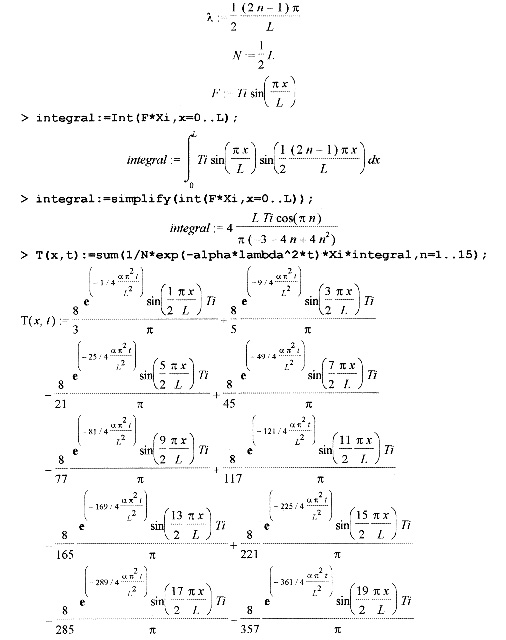
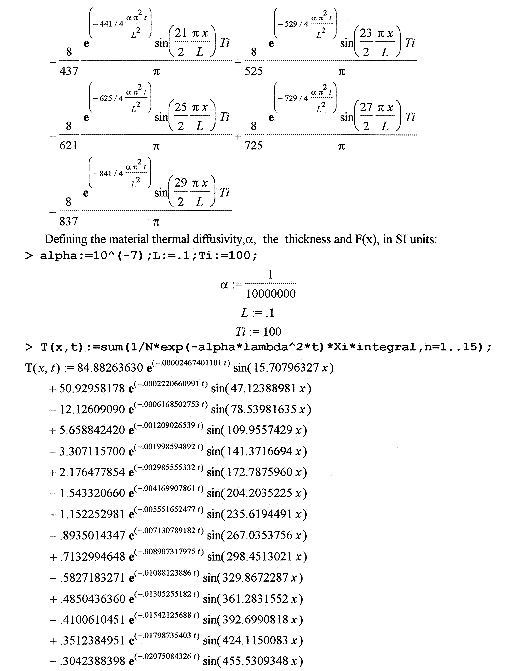
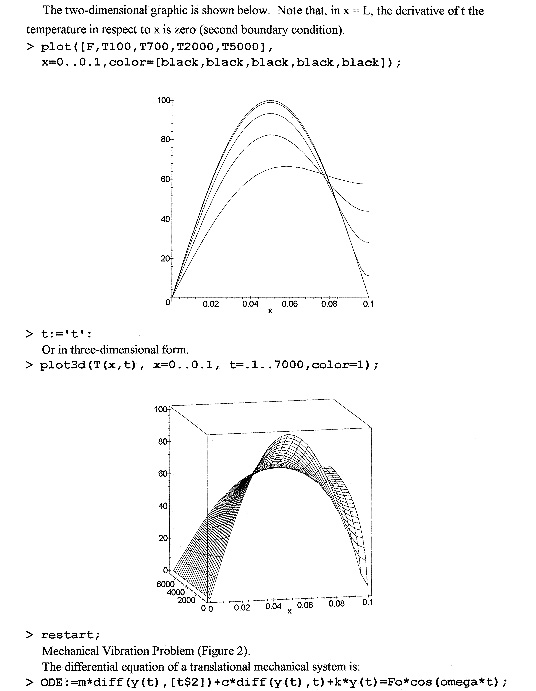
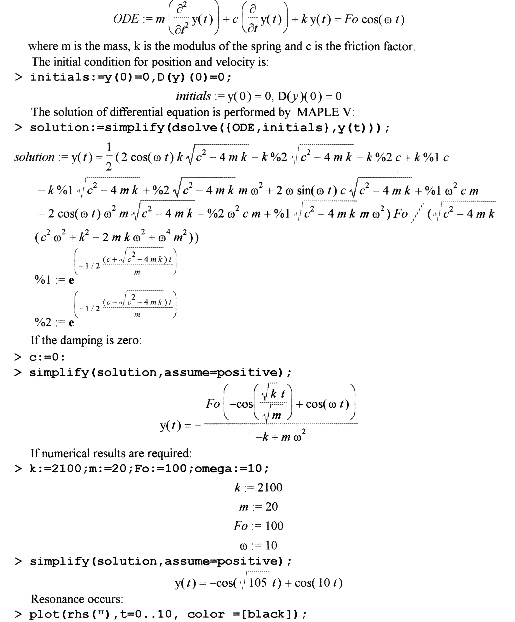
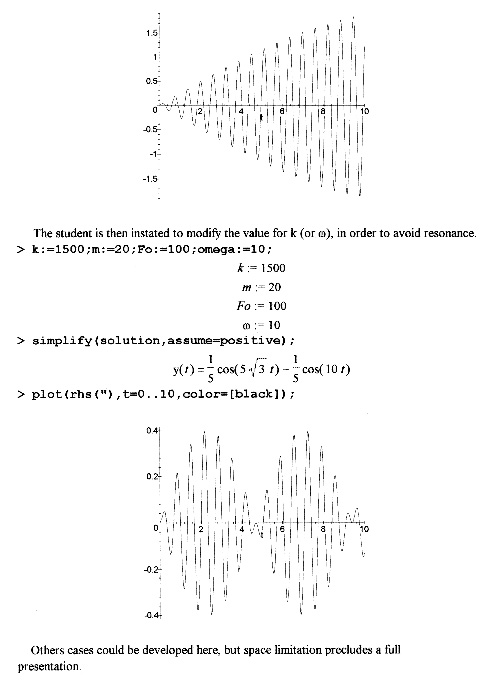
REFERENCES
1. Waterloo Maple Inc., "The Maple Learn Guide", 1995.
2. Waterloo Maple Inc., "The Maple Programming Guide", 1995.
3. Char, B.W.; Geddes, K.; Gonnet, G. H., Leong, B.L.; Monagan, M.B.; Watt, S.M.,
"Maple V Language Reference Manual" - Springer-Verlag, 1991.
4. Char, B.W.; Geddes, K.; Gonnet, G. H., Leong, B.L.; Monagan, M.B.; Watt, S.M.,
"Maple
V Library Reference Manual" - Springer-Verlag, 1991.
5. Char, B.W.; Geddes, K.;; Gonnet, G. H., Leong, B.L.; Monagan, M.B.; Watt, S.M.,
"First Leaves: A Tutorial Introduction To Maple V", Springer-Verlag, 1992.
6. Boundru, W.C.; Fielder,J.R., "Calculus Laboratories with MAPLE V: A Tool, not an
Oracle", Books/Cole Symbolic Computation Series, 1991
7. Robertson, J.S., "Engineering with Mathematica" McGraw-Hill, 1995.
8. Reuther de Siqueira, C.E.; Valardan, J. D., "Extended Fourier Series in DERIVE",
DERIVE
News Letter, Austria, no 09, March 1993.
9. Reuther de Siqueira, C.E.; Valardan, J. D., "Fluid Flow in DERIVE" - DERIVE News
Letter, Austria, no 11, September 1993.
10. Tongue, B.H.; "Principles of Vibration - MATLAB", Oxford University Press, 1996.
11. Heck, André, "Introduction to MAPLE" , Springer Verlag, second edition,
1996.
12. Computer Algebra WWW servers, CAIN, http://www.can.nl; Computer Algebra Fachgruppe,
www.uni-karlshure.de~risc.uni-linz.ac.at/; SymbolicNet, http://symbolicnet.mcs.kent.edu.
13. Schneider, P.J.; "Conduction Heat Transfer", Addison Wesley Publishing Company,
1974
14. Özisik, M. N., "Heat Transfer - A Basic Approach" , McGraw-Hill, 1989.
15. Wylie, C.R.; Barret, L.C., "Advanced Engineering Mathematics", fifth edition, McGraw-
Hill, 1987.